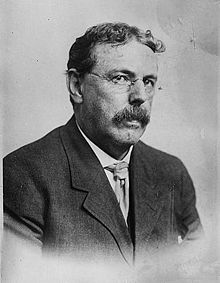- Orville Ward Owen
-
Dr. Orville Ward Owen (January 1, 1854 – March 31, 1924) was an American physician, and exponent of the Baconian theory of Shakespearean authorship. Owen claimed to have discovered hidden messages contained in the works of Shakespeare/Bacon. He deciphered these using a device he invented called a "cipher wheel". The alleged discoveries were published in Owen's multi-volume work Sir Francis Bacon's Cipher Story (1893-5).
Contents
Method
Owen's "cipher wheel" was a device for quickly collating printed pages from the works of Shakespeare, Francis Bacon, and other authors, combining passages that appeared to have some connection with key words or phrases. Owen described this as the word cipher. A one thousand long strip of canvas had on it pasted the works of Shakespeare as well as samples by Christopher Marlowe and other contemporaries. When the wheels turned, key words were highlighted.[1]
The method was examined by cryptologists William and Elizebeth Friedman, who conclude that it has no cryptographic validity.[2] In addition, Dr. Frederick Mann, a close friend of Owen, published a severe critique soon after Owen's book first appeared. Mann wrote that Owen's method means that "we are asked to believe that such peerless creations as Hamlet, The Tempest, and Romeo and Juliet were not prime productions of the transcendent genius who wrote them, but were subsidiary devices which Bacon designed for the purpose of concealing the cipher therein." He also noted that Owen and his assistants gave themselves considerable freedom in choosing and altering passages as they saw fit, even though the cipher-text was supposed to be identified by keywords; "in one instance the keyword is 47 lines away from the quotation taken, and in a large number of instances it is not even to be found on the same page".[3]
Owen drew on the works normally attributed to Bacon, Shakespeare, Robert Greene, George Peele, Edmund Spenser and Robert Burton, all of which he believed had been written by Bacon.
Findings
Owen's book Sir Francis Bacon's Cipher Story (1893-5) stated that Queen Elizabeth I was secretly married to Robert Dudley, Earl of Leicester, who fathered both Bacon and Robert Devereux, 2nd Earl of Essex, later ruthlessly executed by his own mother.[4] This was the basis for what became known as Prince Tudor theory. This secret history of the Elizabethan period was communicated by Bacon through encoded passages in his own works and the many others he had written attributed to other authors. Bacon's hidden messages are communicated in blank verse in the form of a question and answer session, in which a voice asks Bacon questions and receives long verse replies.
When the queen discovered that her son had written Hamlet, Bacon's movements were restricted "circumscribing the free scope of that mighty intellect, and forcing the hiding of its best work under masks and cipher, only to be revealed three hundred years later".[5] It was also revealed that Bacon himself discovered his brother's treasonable plot, and that Romeo and Juliet is the story of Bacon's romance with the Queen of France, Margaret of Valois.[5] Elizabeth confessed that Bacon was her son on her deathbed, but she was poisoned and strangled by Robert Cecil to prevent her proclaiming Bacon her successor. Owen also uncovered two new plays by Bacon, The tragical historie of our late brother Robert, earl of Essex and The historical tragedy of Mary queen of Scots.
Owen was led to the belief that original manuscripts were hidden at Chepstow Castle, and made several expeditions to attempt to recover them in 1909-10. He also dredged a section of the River Wye but nothing was found.[6] Owen died a "bedridden almost penniless invalid", full of regret for sacrificing his career, reputation and health on the "Baconian controversy" and warning admirers to learn by his example and avoid it.[7] His theories were later developed by his assistant Elizabeth Wells Gallup. Owen's cipher wheel was discovered in a warehouse in Detroit[8] by Virginia Fellows (1910-2006), a later supporter of Owen's theory, who presented it to her publisher.
Footnotes
- ^ Times Literary Supplement 24/4/10 p.3
- ^ William Friedman and Elizebeth Friedman, The Shakespearian ciphers examined, Cambridge University Press, 1957.
- ^ William F. Friedman, Elizabeth S. Friedman, The Shakespearean Ciphers Examined: An Analysis of Cryptographic Systems Used as Evidence That Some Author Other Than William Shakespeare Wrote the Plays Commonly Attributed to Him, Cambridge University Press, Cambridge, England, 1957, p.66-7.
- ^ Helen Hackett, Shakespeare and Elizabeth: the meeting of two myths, Princeton University Press, 2009, pp.157-60
- ^ a b Owen, O.W., Sir Francis Bacon's Cipher Story, Introduction.
- ^ Times Literary Supplement 23/4/10 p.3
- ^ Times Literary Supplement 23/4/10 p.3
- ^ The Shakespeare Code - The Cipher Wheel at www.shakespearecode.com
Further reading
- Virginia M. Fellows, The Shakespeare Code, Snow Mountain Press, 2006. ISBN 1932890025.
- O.W. Owen, Sir Francis Bacon's cipher story I-V, Howard Publishing, 1893-5. Reprinted 1995, ISBN 1564595919.
Shakespeare authorship question (History) Theories 
Candidates Supporters - Joseph C. Hart
- Delia Bacon
- Orville Ward Owen
- James Wilde, 1st Baron Penzance
- George Greenwood
- Mark Twain
- Abel Lefranc
- J. Thomas Looney
- Alden Brooks
- Charlton Greenwood Ogburn
- Calvin Hoffman
- Charlton Ogburn
- Roger Stritmatter
- Mark Anderson
- Roland Emmerich
- John Orloff
- Bertram Fields
In popular
culture- Shakespeare Identified (1920 book)
- Anonymous (2011 movie)
Categories:- 1854 births
- 1924 deaths
- Baconian theory of Shakespearean authorship
- American people of Welsh descent
Wikimedia Foundation. 2010.


